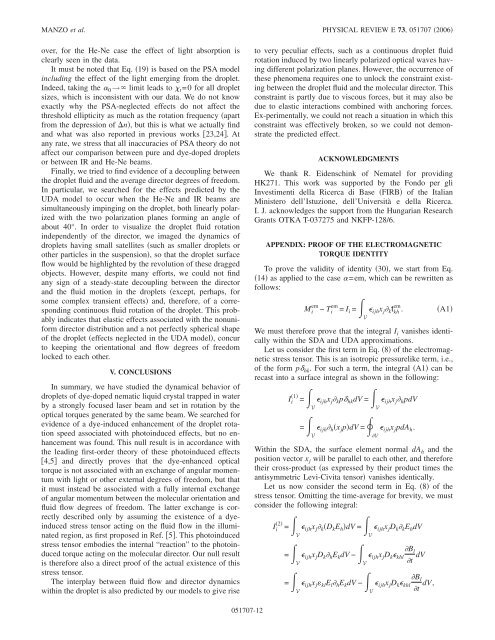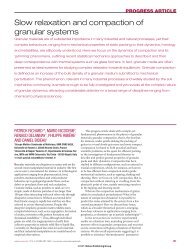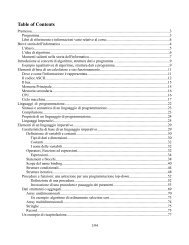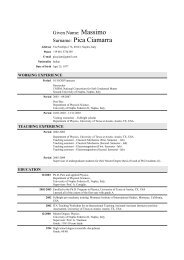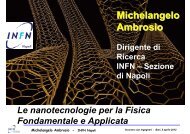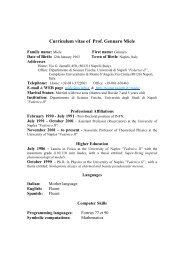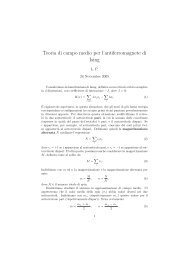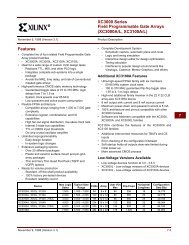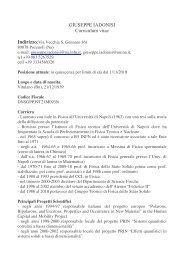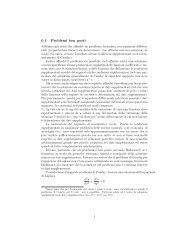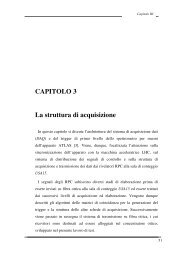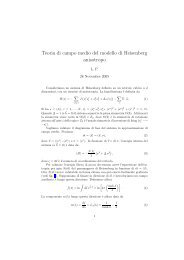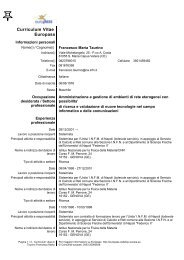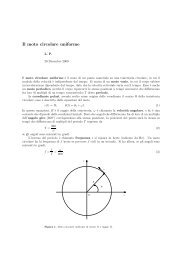Phys Rev E
Phys Rev E
Phys Rev E
Create successful ePaper yourself
Turn your PDF publications into a flip-book with our unique Google optimized e-Paper software.
MANZO et al. PHYSICAL REVIEW E 73, 051707 2006<br />
over, for the He-Ne case the effect of light absorption is<br />
clearly seen in the data.<br />
It must be noted that Eq. 19 is based on the PSA model<br />
including the effect of the light emerging from the droplet.<br />
Indeed, taking the 0→ limit leads to t=0 for all droplet<br />
sizes, which is inconsistent with our data. We do not know<br />
exactly why the PSA-neglected effects do not affect the<br />
threshold ellipticity as much as the rotation frequency apart<br />
from the depression of n, but this is what we actually find<br />
and what was also reported in previous works 23,24. At<br />
any rate, we stress that all inaccuracies of PSA theory do not<br />
affect our comparison between pure and dye-doped droplets<br />
or between IR and He-Ne beams.<br />
Finally, we tried to find evidence of a decoupling between<br />
the droplet fluid and the average director degrees of freedom.<br />
In particular, we searched for the effects predicted by the<br />
UDA model to occur when the He-Ne and IR beams are<br />
simultaneously impinging on the droplet, both linearly polarized<br />
with the two polarization planes forming an angle of<br />
about 40°. In order to visualize the droplet fluid rotation<br />
independently of the director, we imaged the dynamics of<br />
droplets having small satellites such as smaller droplets or<br />
other particles in the suspension, so that the droplet surface<br />
flow would be highlighted by the revolution of these dragged<br />
objects. However, despite many efforts, we could not find<br />
any sign of a steady-state decoupling between the director<br />
and the fluid motion in the droplets except, perhaps, for<br />
some complex transient effects and, therefore, of a corresponding<br />
continuous fluid rotation of the droplet. This probably<br />
indicates that elastic effects associated with the nonuniform<br />
director distribution and a not perfectly spherical shape<br />
of the droplet effects neglected in the UDA model, concur<br />
to keeping the orientational and flow degrees of freedom<br />
locked to each other.<br />
V. CONCLUSIONS<br />
In summary, we have studied the dynamical behavior of<br />
droplets of dye-doped nematic liquid crystal trapped in water<br />
by a strongly focused laser beam and set in rotation by the<br />
optical torques generated by the same beam. We searched for<br />
evidence of a dye-induced enhancement of the droplet rotation<br />
speed associated with photoinduced effects, but no enhancement<br />
was found. This null result is in accordance with<br />
the leading first-order theory of these photoinduced effects<br />
4,5 and directly proves that the dye-enhanced optical<br />
torque is not associated with an exchange of angular momentum<br />
with light or other external degrees of freedom, but that<br />
it must instead be associated with a fully internal exchange<br />
of angular momentum between the molecular orientation and<br />
fluid flow degrees of freedom. The latter exchange is correctly<br />
described only by assuming the existence of a dyeinduced<br />
stress tensor acting on the fluid flow in the illuminated<br />
region, as first proposed in Ref. 5. This photoinduced<br />
stress tensor embodies the internal “reaction” to the photoinduced<br />
torque acting on the molecular director. Our null result<br />
is therefore also a direct proof of the actual existence of this<br />
stress tensor.<br />
The interplay between fluid flow and director dynamics<br />
within the droplet is also predicted by our models to give rise<br />
051707-12<br />
to very peculiar effects, such as a continuous droplet fluid<br />
rotation induced by two linearly polarized optical waves having<br />
different polarization planes. However, the occurrence of<br />
these phenomena requires one to unlock the constraint existing<br />
between the droplet fluid and the molecular director. This<br />
constraint is partly due to viscous forces, but it may also be<br />
due to elastic interactions combined with anchoring forces.<br />
Ex-perimentally, we could not reach a situation in which this<br />
constraint was effectively broken, so we could not demonstrate<br />
the predicted effect.<br />
ACKNOWLEDGMENTS<br />
We thank R. Eidenschink of Nematel for providing<br />
HK271. This work was supported by the Fondo per gli<br />
Investimenti della Ricerca di Base FIRB of the Italian<br />
Ministero dell’Istuzione, dell’Università e della Ricerca.<br />
I. J. acknowledges the support from the Hungarian Research<br />
Grants OTKA T-037275 and NKFP-128/6.<br />
APPENDIX: PROOF OF THE ELECTROMAGNETIC<br />
TORQUE IDENTITY<br />
To prove the validity of identity 30, we start from Eq.<br />
14 as applied to the case =em, which can be rewritten as<br />
follows:<br />
em em em<br />
Mi − Ti = Ii = ijhxjktkh . A1<br />
V<br />
We must therefore prove that the integral I i vanishes identically<br />
within the SDA and UDA approximations.<br />
Let us consider the first term in Eq. 8 of the electromagnetic<br />
stress tensor. This is an isotropic pressurelike term, i.e.,<br />
of the form p hk. For such a term, the integral A1 can be<br />
recast into a surface integral as shown in the following:<br />
1<br />
Ii = ijhxjkphkdV = ijhxjhpdV V<br />
V<br />
= ijhhxjpdV = ijhxjpdAh. V<br />
V<br />
Within the SDA, the surface element normal dA h and the<br />
position vector x j will be parallel to each other, and therefore<br />
their cross-product as expressed by their product times the<br />
antisymmetric Levi-Civita tensor vanishes identically.<br />
Let us now consider the second term in Eq. 8 of the<br />
stress tensor. Omitting the time-average for brevity, we must<br />
consider the following integral:<br />
2<br />
Ii = ijhxjkDkEhdV = ijhxjDkkEhdV V<br />
V<br />
Bl = ijhxjDkhEkdV − ijhxjDkkhl V<br />
V<br />
t dV<br />
Bl = ijhxjklElhEkdV − ijhxjDkkhl V<br />
V<br />
t dV,


